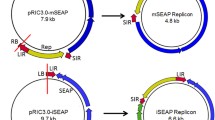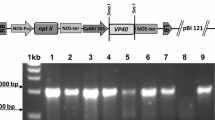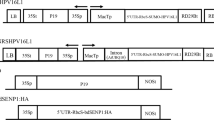Abstract
We investigated the potential of Nicotiana benthamiana to express the E7 protein of human papillomavirus 8 (HPV-8), a paradigm genotype among cutaneous HPVs. The protein, modified in its putative pRb-binding domain (E7QGD), was transiently expressed in leaves following infiltration with agrobacteria carrying either a binary vector combined with silencing suppressor constructs or replicating tobacco mosaic virus (TMV)-based vectors with different targeting signals. HPV-8 E7QGD yields ranged from 250 ng to 4.6 mg per gram of fresh leaf tissue. The highest yields were obtained with TMV-based vectors targeting the antigen to the apoplast. HPV8-CER (H2q) mice transformed with the complete early region of HPV-8 showed a delay in the onset of skin papillomatous lesions and produced E7-specific immunoglobulins G when inoculated subcutaneously with leaf extracts expressing E7QGD. Furthermore, we demonstrated that the plant-made HPV-8 E7QGD induced a specific cytotoxic response in C57BL/6 (H2b) mice.



Similar content being viewed by others
References
Ma JKC, Barros E, Bock R, Christou P, Dale PJ, Dix PJ, Fischer R, Irwin J, Mahoney R, Pezzotti M, Schillberg S, Sparrow P, Stoger E, Twyman RM (2005) Molecular farming for new drugs and vaccines—current perspectives on the production of pharmaceuticals in transgenic plants. EMBO Rep 6:593–599
Rybicky ED (2010) Plant-made vaccines for humans and animals. Expert Rev Vaccines 8:620–637
Kapusta J, Modelska A, Figlerowicz M, Pniewski T, Letellier M, Lisowa O, Yusibov V, Koprowski H, Plucienniczak A, Legocki AB (1999) A plant-derived edible vaccine against hepatitis B virus. FASEB J 13:1796–1799
Tacket CO, Mason HS, Losonsky G, Clements JD, Levine MM, Arntzen CJ (1998) Immunogenicity in humans of a recombinant bacterial antigen delivered in a transgenic potato. Nat Med 4:607–609
Streatfield SJ (2006) Mucosal immunization using recombinant plant-based oral vaccines. Methods 38:150–157
Lico C, Chen Q, Santi L (2008) Viral vectors for production of recombinant proteins in plants. J Cell Physiol 216:366–377
Ghittoni R, Accardi R, Hasan U, Gheit T, Sylla B, Tommasino M (2010) The biological properties of E6 and E7 oncoproteins from human papillomaviruses. Virus Genes 40:1–13
Campo MS (2006) Introduction. In: Campo MS (ed) Papillomavirus research from natural history to vaccines and beyond. Caister Academic Press, Wymonham, pp 1–2
Howley PM, Lowy DR (2007) Papillomaviruses. In: Knipe DM, Howley PM (eds) Fields virology, 5th edn. Lippincott/Williams & Wilkins, Philadelphia, pp 2299–2354
rnbauer R, Lenz P, Okun MM (2008) Human papillomavirus. In: Bolognia J, Jorizzo J, Rapini R (eds) Dermatology. Mosby, London, pp 1183–1198
Rittà M, De Andrea M, Mondini M, Mazibrada J, Giordano C, Pecorari G, Garzaro M, Landolfo V, Schena M, Chiusa L, Landolfo S (2009) Cell cycle and viral and immunologic profiles of head and neck squamous cell carcinoma as predictable variables of tumor progression. Head Neck 31:318–327
Weissenborn SJ, Nindl I, Purdie K, Harwood C, Proby C, Breuer J, Majewski S, Pfister H, Wieland U (2005) Human papillomavirus-DNA loads in actinic keratoses exceed those in non-melanoma skin cancers. J Invest Dermatol 125:93
Bouwes Bavinck JN, Euvrard S, Naldi L, Nindl I, Proby CM, Neale R, Abeni D, Tessari GP, Feltkamp MC, Claudy A, Stockfleth E, Harwood CA (2007) Keratotic skin lesions and other risk factors are associated with skin cancer in organ-transplant recipients: a case–control study in The Netherlands, United Kingdom, Germany, France, and Italy. J Invest Dermatol 127:1647–1656
Bouwes Bavinck JN, Plasmeijer EI, Feltkamp MC (2008) Beta-papillomavirus infection and skin cancer. J Invest Dermatol 128:1355–1358
Asgari MM, Kiviat NB, Critchlow CW, Stern JE, Argenyi ZB, Raugi GJ, Berg D, Odland PB, Hawes SE, de Villiers EM (2008) Detection of human papillomavirus DNA in cutaneous squamous cell carcinoma among immunocompetent individuals. J Invest Dermatol 128:1409–1417
Gormley RH, Kovarik CL (2009) Dermatologic manifestations of HPV in HIV-infected individuals. Curr HIV/AIDS Rep 6:130–138
Ateenyi-Agaba C, Franceschi S, Wabwire-Mangen F, Arslan A, Othieno E, Binta-Kahwa J, van Doorn LJ, Kleter B, Quint W, Weiderpass E (2010) Human papillomavirus infection and squamous cell carcinoma of the conjunctiva. Br J Cancer 102:262–267
Hebner CM, Laimins LA (2006) Human papillomaviruses: basic mechanisms of pathogenesis and oncogenicity. Rev Med Virol 16:83–97
Bouvard V, Gabet AS, Accardi R, Sylla BS, Tommasino M (2006) The cutaneous human papillomavirus types and non-melanoma skin cancer. In: Campo MS (ed) Papillomavirus research from natural history to vaccines and beyond. Caister Academic Press, Wymonham, pp 269–277
Dang C, Köhler A, Forschner T, Sehr P, Michael K, Pawlita M, Stockfleth E, Nindl I (2006) E6/E7 expression of human papillomavirus types in cutaneous squamous cell dysplasia and carcinoma in immunosuppressed organ transplant recipients. Br J Dermatol 155:129–136
Dong W, Kloz U, Accardi R, Caldeira S, Tong W, Wang Z, Jansen L, Durst M, Sylla B, Gissmann L, Tommasino M (2005) Skin hyperproliferation and susceptibility to chemical carcinogenesis in transgenic mice expressing E6 and E7 of human papillomavirus type 38. J Virol 79:14899–14908
Michel A, Kopp-Schneider A, Zentgraf H, Gruber AD, de Villiers EM (2006) E6/E7 expression of human papillomavirus type 20 (HPV-20) and HPV-27 influences proliferation and differentiation of the skin in UV-irradiated SKH-hr1 transgenic mice. J Virol 80:11153–11164
Marcuzzi GP, Hufbauer M, Kasper HU, Weissenborn SJ, Smola S, Pfister H (2009) Spontaneous tumor development in human papillomavirus type 8 E6 transgenic mice and rapid induction by UV-light exposure and wounding. J Gen Virol 90:2855–2864
Hufbauer M, Lazić D, Akgül B, Brandsma JL, Pfister H, Weissenborn SJ (2010) Enhanced human papillomavirus type 8 oncogene expression levels are crucial for skin tumorigenesis in transgenic mice. Virology 403:128–136
Schaper ID, Marcuzzi GP, Weissenborn SJ, Kasper HU, Dries V, Smyth N, Fuchs P, Pfister H (2005) Development of skin tumors in mice transgenic for early genes of human papillomavirus type 8. Cancer Res 65:1394–1400
Nindl I, Gottschling M, Stockfleth E (2007) Human papillomaviruses and non-melanoma skin cancer: basic virology and clinical manifestations. Dis Markers 23:247–259
Handisurya A, Schellenbacher C, Kirnbauer R (2009) Diseases caused by human papillomaviruses (HPV). J Dtsch Dermatol Ges. 7:453–466
Frazer IH (2004) Prevention of cervical cancer through papillomavirus vaccination. Nat Rev Immunol 4:46–54
Leggatt GR, Frazer IH (2007) HPV vaccines: the beginning of the end for cervical cancer. Curr Opin Immunol 19:232–238
Giorgi C, Franconi R, Rybicky EP (2010) Human papillomavirus vaccines in plants. Expert Rev Vaccines 8:913–924
Bevan M (1984) Binary agrobacterium vectors for plant transformation. Nucleic Acids Res 12:8711–8721
Gleba Y, Marillonnet S, Klimyuk V (2004) Engineering viral expression vectors for plants: the ‘full virus’ and the ‘deconstructed virus’ strategies. Curr Opin Plant Biol 7:182–188
Borisjuk N, Sitailo L, Adler K, Malysheva L, Tewes A, Borisjuk L, Manteuffel R (1998) Calreticulin expression in plant cells: developmental regulation, tissue specificity and intracellular distribution. Planta 206:504–514
McMaster GK, Carmichael GG (1977) Analysis of single- and double-stranded nucleic acids on polyacrylamide and agarose gels by using glyoxal and acridine orange. Proc Natl Acad Sci USA 74:4835–4838
Mastini C, Becker PD, Iezzi M, Curcio C, Musiani P, Forni G, Cavallo F, Guzman CA (2008) Intramammary application of non-methylated-CpG oligodeoxynucleotides (CpG) inhibits both local and systemic mammary carcinogenesis in female BALB/c Her-2/neu transgenic mice. Curr Cancer Drug Targets 8:230–242
Johansen LK, Carrington JC (2001) Silencing on the spot. Induction and suppression of RNA silencing in the Agrobacterium-mediated transient expression system. Plant Physiol 126:930–938
Voinnet O, Rivas S, Mestre P, Baulcombe D (2003) An enhanced transient expression system in plants based on suppression of gene silencing by the p19 protein of tomato bushy stunt virus. Plant J 33:949–956
Kim KI, Sunter G, Bisaro DM, Chung IS (2007) Improved expression of recombinant GFP using a replicating vector based on Beet curly top virus in leaf-disks and infiltrated Nicotiana benthamiana leaves. Plant Mol Biol 64:103–112
Marillonnet S, Giritch A, Gils M, Kandzia R, Klimyuk V, Gleba Y (2004) In planta engineering of viral RNA replicons: efficient assembly by recombination of DNA modules delivered by Agrobacterium. Proc Natl Acad Sci USA 101:6852–6857
Gleba Y, Klimyuk V, Marillonnet S (2007) Viral vectors for the expression of proteins in plants. Curr Opin Biotech 18:134–141
Franconi R, Massa S, Illiano E, Mullar A, Cirilli A, Accardi L, Di Bonito P, Giorgi C, Venuti A (2006) Exploiting the plant secretory pathway to improve the anticancer activity of a plant-derived HPV16 E7 vaccine. Int J Immunopathol Pharmacol 19:187–197
Franconi R, Di Bonito P, Dibello F, Accardi L, Muller A, Cirilli A, Simeone P, Dona MG, Venuti A, Giorgi C (2002) Plant-derived human papillomavirus 16 E7 oncoprotein induces immune response and specific tumor protection. Cancer Res 62:3654–3658
Massa S, Franconi R, Brandi R, Muller A, Mett V, Yusibov V, Venuti A (2007) Anti-cancer activity of plant-produced HPV16 E7 vaccine. Vaccine 25:3018–3021
Kanodia S, Fahey LM, Kast WM (2007) Mechanisms used by human papillomaviruses to escape the host immune response. Curr Cancer Drug Targets 7:79–89
Khammanivong V, Liu XS, Liu WJ, Rodda SJ, Leggatt GR, Tindle RW, Frazer IH, Fernando GJ (2003) Paucity of functional CTL epitopes in the E7 oncoprotein of cervical cancer associated human papillomavirus type 16. Immunol. Cell Biol 81:1–7
Pfister H (2003) Chapter 8: human papillomavirus and skin cancer. J Natl Cancer Inst Monogr 31:52–56
Handisurya A, Gambhira R, Schellenbacher C, Shafti-Keramat S, Forslund O, Favre M, Kimbauer R (2009) Serological relationship between cutaneous human papillomavirus types 5, 8 and 92. J Gen Virol 90:136–143
Purdie K, Surentheran T, Sterling J, Bell L, McGregor J, Proby C, Harwood C, Breuer J (2005) Human papillomavirus gene expression in cutaneous squamous cell carcinomas from immunosuppressed and immunocompetent individuals. J Invest Dermatol 125:98–107
Orth G (2006) Genetics of epidermodysplasia verruciformis: insights into host defense against papillomaviruses. Semin Immunol 18:362–374
Acknowledgments
We acknowledge Icon Genetics for providing the TMV-based vectors. We are indebted to Drs. Marco De Andrea and Michele Mondini for their contribution in producing the anti GST-E7 rabbit serum, to Mrs. Manuela Vecchiati for plant care and to Prof. Guido Forni for helpful advice. This work was supported by Ricerca Sanitaria Finalizzata, Regione Piemonte, Italy, and by the EU FP7 “PLAPROVA” project (Grant Agreement No. KBBE-227056).
Author information
Authors and Affiliations
Corresponding author
Rights and permissions
About this article
Cite this article
Noris, E., Poli, A., Cojoca, R. et al. A human papillomavirus 8 E7 protein produced in plants is able to trigger the mouse immune system and delay the development of skin lesions. Arch Virol 156, 587–595 (2011). https://doi.org/10.1007/s00705-010-0893-8
Received:
Accepted:
Published:
Issue Date:
DOI: https://doi.org/10.1007/s00705-010-0893-8




